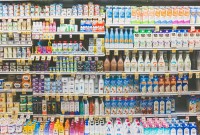- Home
- Business Processes
- Industry Knowledge
- Aerospace Industry
- Automotive Industry
- Banking Domain
- BFSI Industry
- Consumer/ FMCG Industry
- Chemicals Industry
- Engineering & Construction
- Energy Industry
- Education Domain
- Finance Domain
- Hospitality Domain
- Healthcare Industry
- Insurance Domain
- Retail Industry
- Travel and Tourism Domain
- Telecom Industry
- Leadership Skills
- eLearning
- Home
- Domain Knowledge
- Retail Industry
- Business Dynamics of Consumer Industry
Business Dynamics of Consumer Industry
The consumer goods industry is impacted by many dynamics like economic considerations, product considerations, price considerations that impact consumer buying choices. Advertisements, branding, marketing, variety of goods, and technology are the main drivers. Manufactures, retailers, warehousing, and logistics are all part of the supply chain for the consumer goods industry.
Economic Considerations – Buying Power of Consumers
Consumers' buying decisions are the outcome of economic influence which comprises income, price, and technology, the economy of purchase, dependability, quality, and operational effectiveness of the product. These factors significantly affect consumers' decision-making processes.
Income is a primary economic influence determining the consumption expenditure of individuals. Personal disposable income is the number of money people is left with after paying the taxes. Consumers, on the basis of income, are grouped as upper-class, middle class, working-class, and low-income groups. Increases in income influence the buying habits of the consumer.
Consumer expenditures are also affected by savings and debt patterns. Consumers can increase their purchasing power also through borrowing. The availability of consumer credit due to the development of banking and financial institutions has been a major contributor to the growth of consumer spending. This enables people to buy more than their current income or salaries allow, thus creating more jobs and still more income and more demand.
Product Considerations
A product can be defined as anything that can be offered to a group of consumers for attention, acquisition, use, or consumption that might satisfy a need or a want. It includes physical objects, services, persons, places, organizations, and ideas.
Products are packaged and labeled and various customer services may be offered along with the product. All these criteria exert a considerable collective influence on buyers. Brand names, for example, tell the buyer something about product quality. Packaging which imparts benefits such as protection, economy, and convenience, also influence buyers' decisions.
Price Considerations
In spite of the increased role of non-price factors in influencing consumer behavior, the price remains an important factor. The consumer decides whether the price is right for the product a company is selling. The consumer, before purchasing, weighs the price against the perceived values of using the product. Consumers differ in the values they assign to different product features and marketers often vary their pricing strategies for different consumer segments.
Sales at a concessional price, price reductions, discount offers, and free gifts are commonly used as sales promotion tools by marketers. Consumers sometimes defer purchases to avail of price reductions during an off-season sale.
Advertisements & Marketing
Advertisements today have an important influence on consumers. Advertising has emerged as a potent promotional tool in enhancing sales of existing products and introducing new products. Companies use advertising to increase the awareness of consumers through the communication of persuasive information about their products, services, or organizations.
A number of advertising agencies have sprung up to help the manufacturer in his efforts to achieve the above aims, but the consumer is often left in a state of confusion. This is because ads exploit the emotions of people without giving much information that would help the consumer to make considered choices. It will be noticed that the above aims of manufacturers do not include consumer satisfaction. It is therefore up to the consumer to look after his own interests because ads can be competitive, deceptive, or corrective in nature. Judge for yourself, but beware you don't fall into the trap of the manufacturers or persuasive efforts of the ads.
Branding
Marketing, advertising, and brand differentiation are key considerations for companies in the consumer goods sector. Many consumer goods sector companies are faced with a range of close competitors, substitute goods, and potential rivals. Competition on price and quality is often fierce, so brand identification and differentiation are critical to consumer goods sector companies' performance.
Variety of Goods
General consumer products range from utilitarian goods such as shoes and pens and pencils to cutting-edge technology such as iPads and smartphones.
There is also a wide range of quality and price within each product category.
Manufactures of Consumer Goods
Manufacturers range from massive, multinational corporations to small firms with fewer than 50 employees.
There are tens of thousands of general consumer products manufacturers in the United States. They compete to develop the best products at the most affordable price for the greatest number of consumers.
Some companies are part of traditional sectors (such as the clothing industry) that have existed for many years, while others, such as Apple and Dell, are part of the technology sector, which has emerged only in the last three decades.
Supply Chain for Consumer Industry
The industry has close relationships with other industries, including transportation, packaging, agriculture, chemicals, plastics, rubber, metal, stone, ceramics, and petroleum, which provide many of the raw materials that are used to make consumer products.
Role of Retailers
Typically, CPG merchandise is sold by retailers in physical brick and mortar stores and packaging is designed to differentiate a product from its competitors on a pharmacy, grocery, or big box store shelf. Because shelf space is a finite commodity, the CPG market is highly competitive. Retail is a major aspect of the general consumer products industry. Retailers sell the products that manufacturers produce. Retail stores are located in nearly every town and city. These include department stores, supermarkets, “big box” stores, and drugstores. Many companies sell products online.
Career Paths in Consumer Industry
Workers with a wide range of educational backgrounds and skills are employed in the general consumer products industry.
Career paths include those in product development (such as product design), manufacturing, marketing, sales, administrative support, law (especially intellectual property and labor law), and other fields.
Influence of Technology
Until recently, it’s been difficult for manufacturers to take advantage of the internet and sell CPG through e-commerce channels. The most dramatic force shaping people's consumption is perhaps technology. Technological advancement is at the heart of consumer goods sector industry trends. Technological advancement has revolutionized supply chains, marketing, and the products themselves in this sector. It has released forces of change in production processes and the nature of products. Many of today's common products were not available a hundred years ago. The consumer today, is, therefore, constantly subjected to the advent of new products, which claim features of greater efficiency, comfort, speed, and reliability.
Using new technologies, many consumer goods sector companies are engaging with consumers in more direct and innovative ways. The consumer today has not only a wider range of products to choose from; he also has an enhanced variety and brands of products available for purchase.
Related Links
You May Also Like
-
Challenges in Consumer Goods Industry
There are tens of thousands of general consumer products manufacturers in the United States. They compete to develop the best products at the most affordable price for the greatest number of consumers. Challenges for these organizations include meeting the changing demands of customers, maneuvering through a consolidating market, and executing strategies to grow profitably.
-
All of us are consumers, from cradle to grave, to be more precise, from the womb to grave or cremation. In a sense, the history of the consumer is the history of mankind. Consumers are the largest economic group in any country. They are the central point of all of our economic activities. But the very same consumers ate the most voiceless group also. The nature of consumer in terms of needs, consumption patterns, and problems has been changing and evolving along with the social and economic development in the course of history.
-
Retail Industry: Current Challenges
Today consumers are choosing multichannel buying experiences and expect that to be a seamless experience. To attract customer loyalty, retailers need to provide an experience that stands out from others. Learn the challenges faced by the retail sector today. Multi-channel sale avenues, changing consumer behavior, technological advances, rising competition, rising frauds, and supply chain management are some of them that require immediate attention.
-
From an economic standpoint, there are three main types of consumer goods: durable goods, nondurable goods, and services. For marketing purposes, consumer goods can be grouped into different categories based on consumer behavior, how consumers shop for them, and how frequently consumers shop for them. One of the largest consumer goods groups is called fast-moving consumer goods. This segment includes nondurable goods like food and drinks that move rapidly through the chain from producers to distributors and retailers than on to consumers.
-
The consumer goods sector is a category of stocks and companies that relate to items purchased by individuals and households rather than by manufacturers and industries. These companies make and sell products that are intended for direct use by the buyers for their own use and enjoyment. This sector includes companies involved with food production, packaged goods, clothing, beverages, automobiles, and electronics. Nestle, Procter & Gamble, and Pepsico are some of the world’s largest consumer goods companies in the world.
-
Durable goods are consumer goods that have a long life span (e.g. 3+ years) and are used over time. Highly durable goods such as refrigerators, cars, or mobile phones usually continue to be useful for three or more years of use, and hence durable goods are typically characterized by long periods between successive purchases.
-
Competitive Landscape of Retail Industry
In an increasingly competitive landscape, retail industry players must compete in a number of ways. In this article, we will learn about the competitive landscape of the retail industry. Learn the key players in the retail industry and their business profile. Learn more about the top 5 industry players. Competition is rough, especially for the small business. Knowing how business stacks up to the competition is important to your business strategy.
-
Retail Industry: Key Performance Metrics
You cannot manage what you do not measure and cannot measure what you do not define. Learn the key performance metrics for the retail industry like Sales per square foot, Gross margins return on investment, Average transaction value, Customer retention, Conversion rate, Foot traffic, and digital traffic and Inventory turnover, etc. These metrics are used across the globe by key industry players to track and improve their performance.
-
Consumers benefit from retailing as retailers perform marketing functions that make it possible for customers to have access to a broad variety of products and services. Retailing also helps to create a place, time, and possession utilities. A retailer's service also helps to enhance a product's image. Retailing has a tremendous impact on the economy. It involves high annual sales and employment. Learn the importance of the retail industry in this article.
-
FMCG or consumer packaged goods (CPG) are products that are sold quickly and at relatively low cost, examples include non-durable goods such as soft drinks, toiletries, and grocery items. They generally sell in large quantities, so the cumulative profit on such products can be substantial and these industries often operate on thin margins.
Explore Our Free Training Articles or
Sign Up to Start With Our eLearning Courses

About Us
Learning
© 2023 TechnoFunc, All Rights Reserved









